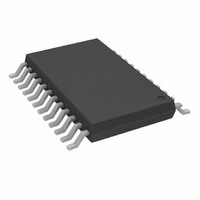ADF7011BRU-REEL7 Analog Devices Inc, ADF7011BRU-REEL7 Datasheet - Page 20

ADF7011BRU-REEL7
Manufacturer Part Number
ADF7011BRU-REEL7
Description
IC,RF Modulator,CMOS,TSSOP,24PIN,PLASTIC
Manufacturer
Analog Devices Inc
Datasheet
1.ADF7011BRUZ-RL.pdf
(24 pages)
Specifications of ADF7011BRU-REEL7
Rohs Status
RoHS non-compliant
Frequency
433 ~ 435MHz; 866 ~ 870MHz
Applications
Data Transfer, RKE, Remote Control/Security Systems
Modulation Or Protocol
ASK, FSK, GFSK, OOK
Data Rate - Maximum
76.8 kbps
Power - Output
-16dBm ~ 12dBm
Current - Transmitting
34mA
Data Interface
PCB, Surface Mount
Antenna Connector
PCB, Surface Mount
Voltage - Supply
2.3 V ~ 3.6 V
Operating Temperature
-40°C ~ 85°C
Package / Case
24-TSSOP
Operating Temperature (min)
-40C
Operating Temperature (max)
85C
Operating Temperature Classification
Industrial
Product Depth (mm)
4.4mm
Operating Supply Voltage (min)
2.3V
Operating Supply Voltage (typ)
2.5/3.3V
Operating Supply Voltage (max)
3.6V
Features
-
Memory Size
-
Lead Free Status / Rohs Status
Not Compliant
ADF7011
APPLICATION EXAMPLES
Application Example 1
Operating Frequency
Output Power
Current Consumption
Modulation
This system should be set up as shown Figure 15. The spurious
levels using a crystal frequency of 4 MHz are sufficiently low so
as not to require any band-pass filtering of the output. However,
2 dB of attenuation will be required at 541.50 MHz in order
to comply with ES-300-220. This can be achieved easily with
the harmonic filter. The harmonic filter can be designed at the
output of the matching network with 50 Ω impedance, or it
may be integrated into the matching network. The ADF7011
will allow multichannel operation in the 433 MHz band. If
FSK modulation is used, the BW should be about five times
the data rate. In the case of ASK modulation, a minimum
data rate of 1 MHz should be used to minimize the occupied
spectrum. The free design tool, ADIsimPLL, should be down-
loaded from www.analog.com/pll to ascertain the values of the
filter components.
Application Example 2
Operating Frequency
Output Power
Current Consumption
Modulation
433.92 MHz
+10 dBm
<30 mA
ASK/FSK
868.3 MHz
+3 dBm
<25 mA
ASK/FSK
–20–
In order to meet the ETSI requirement EN300-220, the maxi-
mum output power without using a filter is +3 dBm. This is
because the spurious levels scale with output power. Utilizing a
PFD frequency of 4.42 MHz will reduce the level of the refer-
ence spurs, and place the first spur in a –36 dBm bin, 4.4 MHz
below the carrier. ADIsimPLL should be used to design the
loop filter, aiming for a loop bandwidth of five times the data
rate for FSK. ASK modulation requires a loop BW > 1 MHz to
minimize spectral occupancy.
Application Example 3
Operating Frequency
Output Power
Current Consumption
Modulation
In order to meet the ETSI requirements at +10 dBm output
power, it is necessary to add an inexpensive GigaFILT from
Murata at the output. This will reduce the prescaler and refer-
ence spurious levels to –54 dBm, and also reduce the harmonic
levels to within the –30 dBm level. Given that the insertion
loss is 2 dB, it is necessary to use the maximum +12 dBm
power from the ADF7011 to achieve an antenna port level of
+10 dBm. The filter layout is important to ensure that there is
margin in the output spectrum; filter data sheet guidelines
should be adhered to.
868.3 MHz
+10 dBm
<40 mA
ASK/FSK
REV. 0














